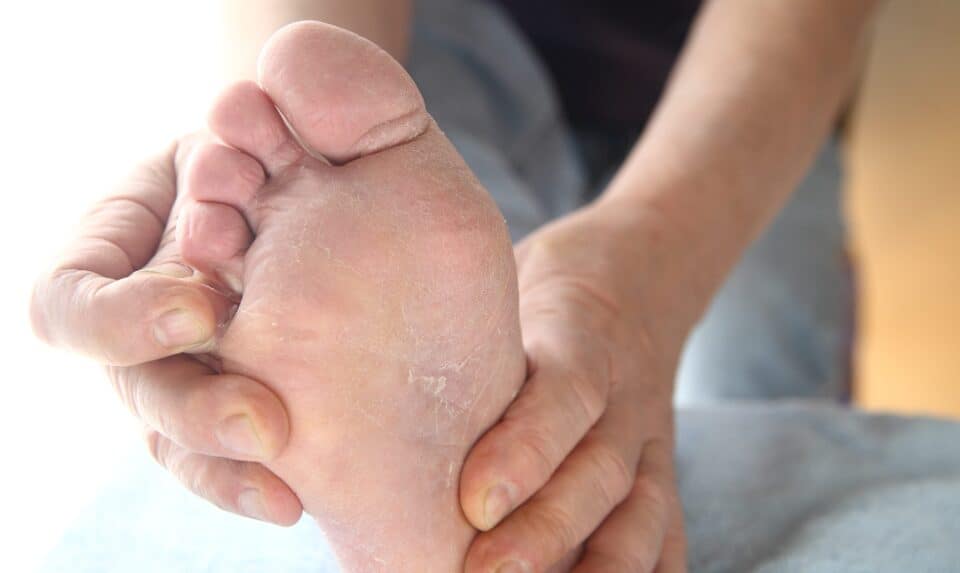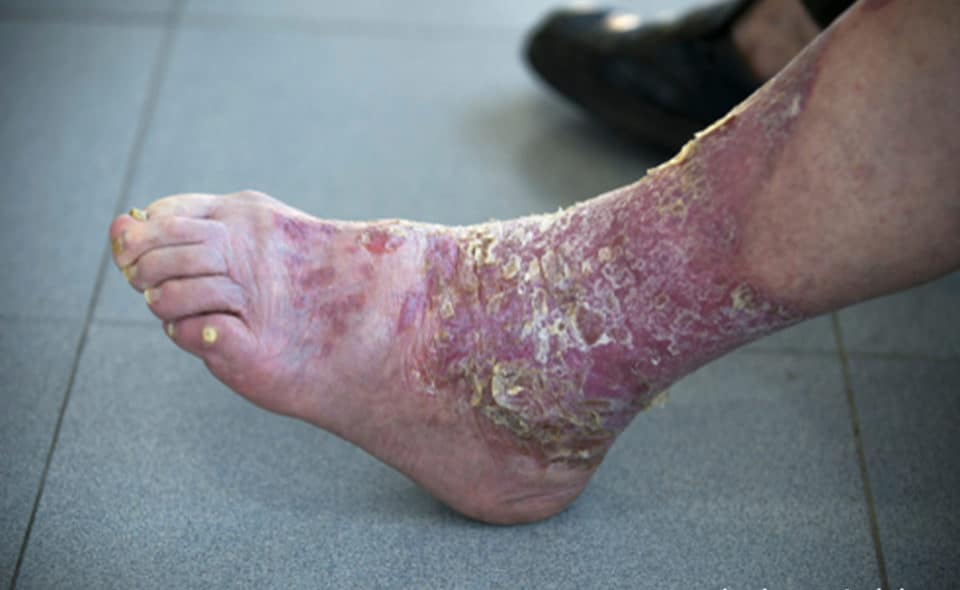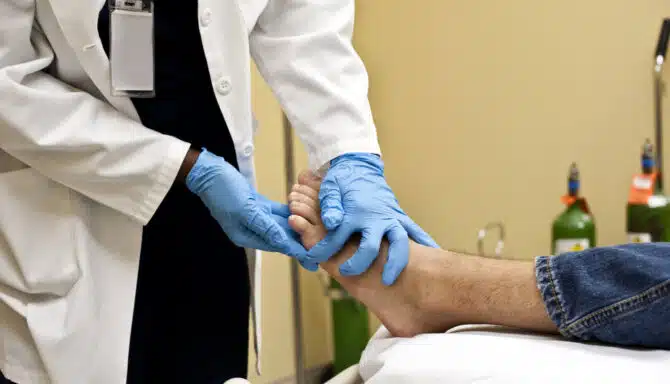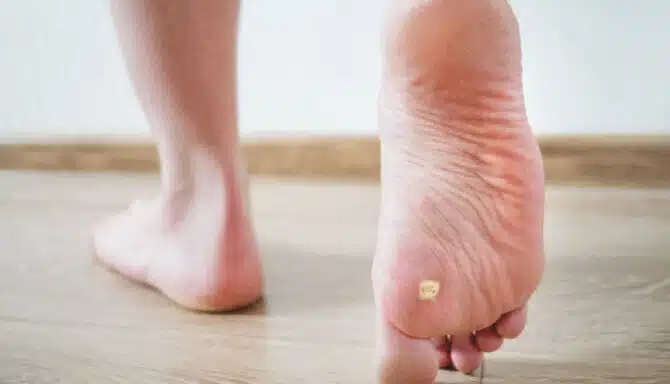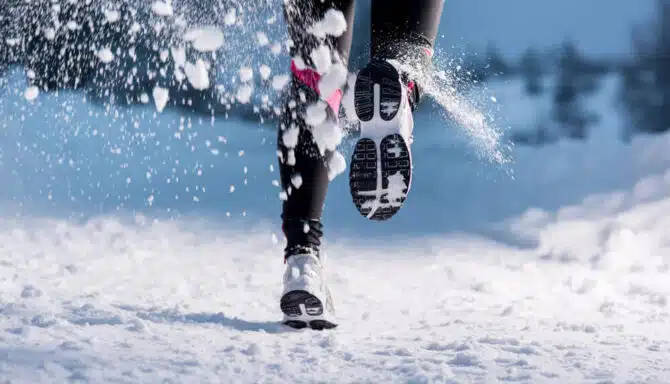Feet peeling can happen at any time. Peeling, flaking and cracked skin can occur in the summer or winter. It can happen with certain sports and even with some conditions. It can be sore, look not nice and in some instances cause an infection.
Are you noticing dry, peeling skin on your feet? You’re not alone! It’s a very common issue. Read on to discover four most common reasons why your feet are peeling, and some of our top tips for how to treat and prevent dry skin.
1. Dry Skin
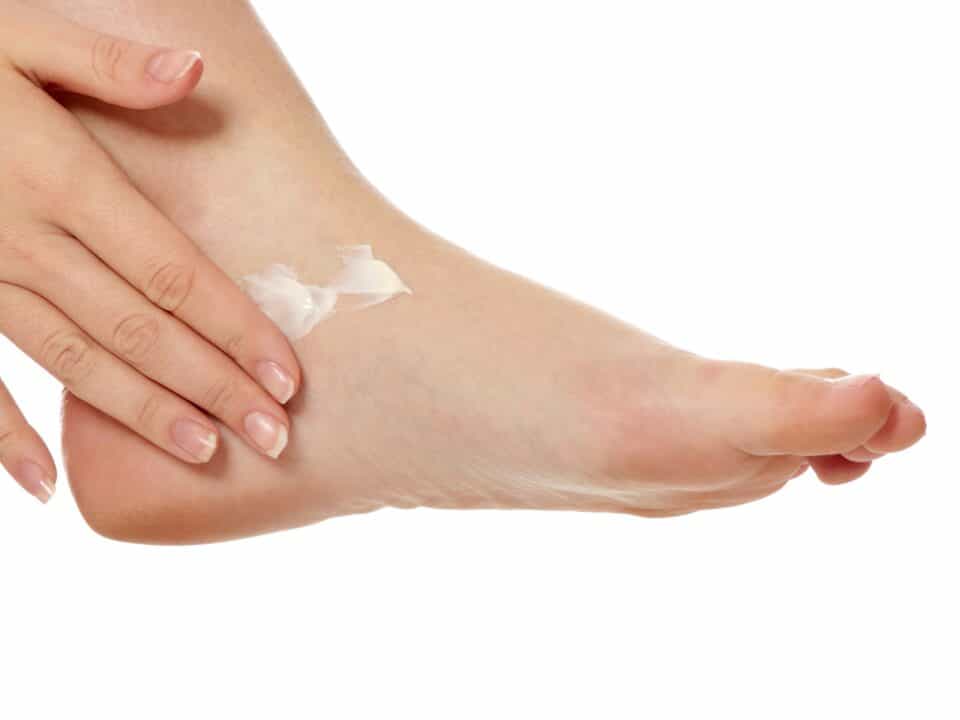
Yep, you guessed it! Dry skin is one of the biggest culprits behind peeling skin in cooler months as the cold air outside mixed with dehydrating heat indoors can leave your feet desperate for moisture. This can cause the skin on your feet to peel and your heels to crack from dehydration. Thankfully, there are many things you can do at home to deal with this issue.
Here’s ways to re-hydrate your feet to prevent dry peeling feet.
- A regular bath and shower is fine, but don’t overdo it. Unless required, excessive bathing can lead to dryness of the skin. It is also helpful to use a mild soap, as harsher soaps can remove oils from our skin
- Pad your skin dry rather than rub
- Apply a fragrance-free moisturizer to lock hydration into your skin. Never apply moisturizer in between your toes- its nice and damp there anyway, it doesn’t need any more moisture.
- Unless required or recommended by a foot specialist, don’t bathe your feet in saltwate r- it can dry your skin out even more
- Be sure to also exfoliate the skin on your feet once a week to remove any dead skin. Just be careful not to do overdo it as it can make the skin sore and red. Using pumice stones are helpful when the feet are damp. When the feet are dry, gently use a foot file for even better results.
2. Athlete’s Foot
Athlete’s Foot can also cause skin peeling along with itchiness, redness, and blistering. The rash will normally start between your toes, but it can then spread to the rest of the foot and cause cracking on the heels. Athlete’s foot is a contagious fungal infection that can be picked up easily from locker rooms, communal showers, pool decks, and any warm moist area where people walk barefoot. Damp socks and shoes also help Athlete’s Foot fester, making Winter and Summer prime seasons for infection.
Athletes foot can also look like dry skin so people apply moisturizers, but this can actually increase the Athletes foot. So, using the right treatment for the right condition is a must! If Athlete’s foot is not properly treated, the cracks in the skin can cause a bacterial infection.
If you’re experiencing foot peeling along with an itchy red rash, you can try a topical anti-fungal cream following the manufacturers instructions. It’s also important to note that Athlete’s foot, like any fungal infection, can be incredibly stubborn and persistent. If you think you may have Athlete’s foot and your symptoms aren’t going away, we recommend seeing a chiropodist for fungal testing and further treatment. Click here to learn more about how a chiropodist can help treat your Athlete’s foot.
3. Eczema
A skin condition that plagues thousands of Canadians, eczema (or atopic dermatitis) can appear anywhere on the body – including your feet! Eczema normally presents as itchy, red patches, but it can also cause skin peeling and cracks. Eczema is usually caused by genetics, an excess of bacteria, or thin layers of skin. It can be exacerbated by environmental factors, like allergens and harsh soaps. The drying effects of winter on your skin, combined with moisture build-up from winter boots and thick socks, can also contribute to flare-ups.
If you think your foot peeling is caused by eczema, we recommend having your feet assessed by a Chiropodist, dermatologist or your family doctor to make sure it is eczema. Ezcema can be managed by:
- Moisturizing your feet at least twice a day to soothe the inflamed skin. When moisturizing, use a non-scented specialty moisturizer suitable for sensitive skin, like Gehwol Med Sensitive or Gehwol Medicated Salve for Cracked Skin.
- Footwear made with breathable materials, like leather, cork or GORE-TEX, that will protect your feet from the elements and foot perspiration.
- Figure out your triggers. Sometimes, stress, fragrances, heat or sweat, dry skin, wool or other environmental factors may exacerbate the eczema.
If moisturizing isn’t quite doing the trick, we recommend consulting with your family doctor or a dermatologist for a prescription cream and to ensure there aren’t any other medical conditions at play, like psoriasis (which is commonly misdiagnosed for eczema).
4. Psoriasis
Psoriasis is another skin condition that can leave scaly red patches on the skin. These patches (called “plaques”) can be sore, itchy, or peeling, and can appear on the soles of the feet. Although often confused with eczema, they are quite different: Unlike eczema, psoriasis is a chronic auto-immune disease; environmental factors therefore do not play as big of a role as they do for eczema. In addition, psoriasis plaques look slightly different than eczema patches.
If you’re concerned about psoriasis on your feet, it’s a good idea to consult with your family doctor. Treating the plaques themselves on your own is a delicate task and can be difficult. Expert foot care by a chiropodist can help soothe the inflamed skin and remove any dead skin buildup without causing irritation. You can also have thickened nails due to Psoriasis.
Psoriasis is common and usually patients have flare-ups that come and go. Psoriasis plaques also tend to follow a pressure pattern based on how you distribute your weight. In some patients, custom orthotics can redistribute your weight and alleviate pressure on certain parts of the foot, which in turn can help reduce pressure on psoriatic plaques or the areas that are prone to them.

How do I stop my feet from peeling?
Peeling feet can be itchy and uncomfortable – but it is definitely treatable and in some cases preventable. Your first step to treat the peeling skin on your feet is a good foot care regimen. This includes:
- Daily Moisturizing: Moisturizing your feet daily with a high-quality moisturizer is your first line of defence against peeling feet. Moisturizing strengthens your skin’s natural protective barrier, which keeps it strong and protects it against the environmental factors that cause skin peeling.
- Exfoliate: Exfoliate your feet once a week with a foot scrub and pumice stone to remove any dead skin. Removing the stockpile of dead skin on your feet lets moisturizer penetrate deeper into the skin, so it can work more effectively.
- Foot care with a Chiropodist: Professional foot care by a foot specialist is one of the most effective ways to treat your peeling skin. A chiropodist will help you find the right treatment for your flaky toes and make recommendations to keep your feet healthy as the seasons change.
- Waterproof and breathable footwear: Staying warm in winter or dry in summer relies on your footwear selection. When selecting boots (or any footwear for that matter) make sure they’re waterproof and breathable. Keeping your feet dry and free of moisture build-up will promote good foot hygiene, which is key to preventing peeling feet.
